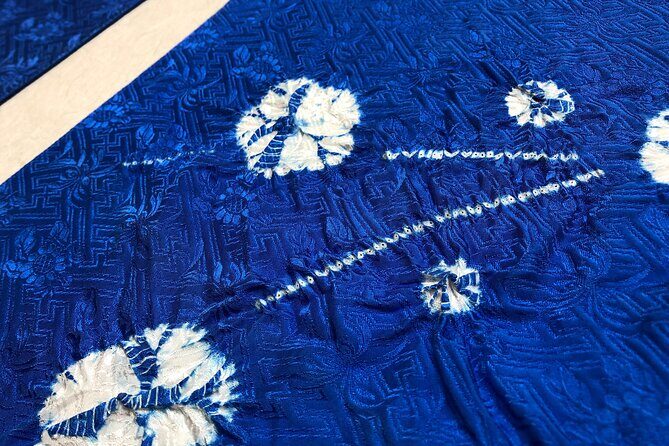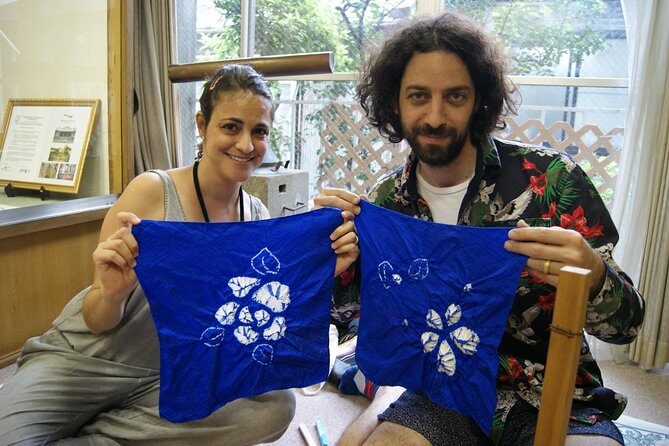Experience the Art of Shibori in Kyoto: A Deep Dive into the Fukusa Shibori Class
If you’re seeking an authentic, hands-on cultural experience in Kyoto, the Fukusa Shibori Class offers a fascinating glimpse into traditional Japanese textile art. For approximately 60 to 90 minutes, you’ll learn about kasamaki and nuishime shibori, two intricate dyeing techniques, under the guidance of an expert craftsman. The class takes place at the Kyoto Shibori Museum, a dedicated space filled with beautiful examples of this centuries-old craft. At just $77.64 per person, this experience delivers more than just a lesson — it offers a chance to create a personalized souvenir and gain insight into Japan’s textile traditions.
What we love most about this class is how approachable and informative it is. The hands-on nature allows you to directly handle traditional tools and fabrics, making the art of shibori accessible even if you’ve never dyed textiles before. The expert guidance from staff and Roy, who is praised for his careful teaching, ensures you’ll leave with a good understanding of the techniques. Plus, the opportunity to explore the museum’s displays offers a visual feast of classic shibori patterns that deepen your appreciation for this craft.
One small consideration? The class is limited to those aged 8 and up, so it’s not suitable for very young children. Also, while the experience’s length is flexible, it’s enough time to get your hands dirty and explore the process thoroughly, but travelers looking for an all-day activity might want to combine this with other Kyoto adventures.
This tour is perfect for anyone curious about Japanese textile arts, those who love hands-on experiences, or travelers who want a meaningful, tangible memory of Kyoto.
Key Points

- Authentic craftsmanship with expert guidance on traditional shibori techniques.
- Create a personalized silk wrapping cloth that’s a beautiful souvenir.
- Explore the Kyoto Shibori Museum’s displays to see stunning examples of the art.
- Learn practical tricks that you can try at home.
- Accessible and family-friendly, with a minimum age of 8.
- Affordable value considering you get a handcrafted item and a cultural lesson.
What to Expect from the Kyoto Shibori Experience
While in Kyoto, here are other experiences we've covered
The Location and Meeting Point
The class starts at the Kyoto Shibori Museum, located at 135-5 Shikiamich in Nakagyo Ward. This central spot is easy to reach via public transportation, with parking for cars and bicycles available. Most travelers seem to find it convenient, and the museum setting offers a cozy, dedicated environment for learning and viewing. The class ends back at the meeting point, making logistics straightforward.
The Itinerary and Techniques
The experience begins with a brief introduction to shibori’s history and significance in Japan, setting the context for this centuries-old craft. Then, the focus shifts to hands-on practice with two specific methods:
- Kasamaki: This involves stitching around a shape, pulling the thread tight, and wrapping the fabric multiple times. It’s a technique that produces stunning, symmetrical patterns and requires a steady hand and patience.
- Nuishime: This method involves stitching along a line and then pulling the thread tight, creating unique textures and patterns on the silk fabric.
Participants dye a silk wrapping cloth (38cm x 38cm), which is carefully stitched, wrapped, and dyed by the group. The result is a beautifully patterned silk piece that you get to take home as a tangible memory of Kyoto.
The Teaching Style and Group Size
With a maximum of 15 travelers, the class maintains an intimate and friendly atmosphere. Roy, the main instructor praised for his careful, supportive teaching style, ensures everyone understands each step. Multiple reviews mention how helpful and enthusiastic the staff are — making the class both educational and enjoyable. The use of traditional tools and fabrics adds an authentic touch, giving you a real sense of working with the same materials used by Japanese artisans for generations.
The Museum and Display Highlights
Beyond the class, the Kyoto Shibori Museum offers a vast display of shibori works, showcasing the diversity of patterns and dyeing styles. For those interested in textile arts, this is a visual feast that complements the hands-on experience and deepens your understanding of the craft’s complexity and beauty.
Pricing and Value
At $77.64 per person, the class is a reasonable investment considering you leave with a custom-made silk piece and a new skill. Many reviews highlight how engaging and worthwhile the experience was — with some even mentioning it was a highlight of their Kyoto trip. The fact that you can learn techniques that are practical to try at home adds to the value.
Who Will Enjoy This?
This class is perfect for couples, families, or solo travelers who enjoy creative pursuits or cultural learning. It’s especially suited for those with an interest in textile arts or Japanese traditions. The hands-on approach creates an engaging environment, and the beautiful displays in the museum inspire further appreciation for the craft.
Why This Tour Matters for Your Kyoto Visit

Kyoto is a city where tradition and craft run deep, and participating in a shibori class provides a rare, personal connection to Japan’s artistic heritage. Unlike more passive sightseeing, this experience allows you to actively participate and gain a new skill, making your visit memorable beyond photos. The museum setting ensures a focused environment, and the class’s duration makes it easy to incorporate into a day of sightseeing.
The Impact of Hands-On Learning
Learning by doing sticks with you, and the techniques of kasamaki and nuishime are surprisingly approachable once demonstrated. The process involves stitching, wrapping, and dyeing, all of which are explained clearly, allowing even beginners to produce a lovely patterned fabric. Many reviewers noted how Roy’s careful guidance helped them understand and enjoy the process.
The Cultural Significance
Shibori is more than just a dyeing technique; it’s a cultural artifact, reflecting Japanese artistry and craftsmanship. Seeing the elaborate patterns displayed in the museum deepens your appreciation for the skill involved. The class also offers insights into how traditional textiles are made, connecting you with Japan’s intangible cultural heritage.
The Practicality and Convenience
The tour’s location near public transit and availability of parking make it accessible. The mobile ticket system simplifies booking, and the class’s short duration makes it a manageable activity even during a busy sightseeing schedule. Plus, the ability to cancel free of charge up to 24 hours in advance offers peace of mind.
Final Thoughts: Who Should Take This Class?

If you’re looking for a meaningful, craft-based activity that provides a tangible keepsake, this shibori class fits the bill. It’s ideal for art lovers, curious travelers, and families wanting a hands-on cultural experience. The focus on traditional techniques and beautiful patterns makes it especially appealing for those interested in Japanese textiles or craftwork.
Travelers who appreciate authentic, well-organized experiences that offer both learning and a memento will find this class rewarding. The positive reviews and high ratings suggest it’s a trusted choice for genuine Kyoto memories.
FAQ
Is this experience suitable for children?
Yes, the minimum age is 8 years, making it suitable for families with older children interested in craft activities.
What is included in the price?
The price covers the class itself, all necessary materials, and your own finished silk wrapping cloth to take home.
How long does the class last?
The experience lasts approximately 60 to 90 minutes, providing enough time for instruction, practice, and creating your piece.
Can I see examples of shibori before booking?
Yes, the museum displays many beautiful shibori samples, highlighting the diversity and artistry of the craft.
Is the class taught in English?
While not explicitly stated, the reviews imply that the instruction is accessible to international travelers, likely in English.
Are there any special requirements or preparations?
No special preparations are needed. Just come prepared to get a bit messy, and wear comfortable clothing that can handle dye.
Can I cancel if my plans change?
Yes, free cancellation is available up to 24 hours before the experience, with full refunds.
Is parking available nearby?
Yes, there are parking spaces for cars and bicycles near the museum.
How many people participate in each class?
Groups are limited to 15 travelers, ensuring a personalized experience with plenty of individual guidance.
To sum it up, the Fukusa Shibori Class at Kyoto Shibori Museum offers a rare opportunity to get hands-on with Japanese textile art, creating a meaningful souvenir that embodies Kyoto’s craftsmanship. Whether you’re interested in art, culture, or just love trying something new, this experience delivers genuine value, expert guidance, and a memorable connection to Japan’s artistic heritage. It’s a fantastic choice for travelers eager to make their Kyoto visit truly special.
More Workshops & Classes in Kyoto
More Tour Reviews in Kyoto
More Kyoto experiences we've covered
- Kimono rental
- Private Tour Guide Kyoto with a Local: Kickstart your Trip, Personalized
- Nanzenji, Eikando, and Ginkakuji Autumn Private Tour in Kyoto
- Kyoto : Immersive Arashiyama and Fushimi Inari by Private Vehicle
- Private Guided Day Tour of Kyoto
- Private Fushimi Inari sightseeing and Nishiki Food Tour
- Kyoto: Half-Day Private Tour Gion Geisha Districts & Kiyomizu
- Kyoto, Nara and Osaka private up to 9 pax picked up from Kyoto
- Private Kyoto Custom One Day Tour by Chartered Vehicle
- Kyoto Photo Shoot by Professional Photographer (77K Followers)
- Private Tea Ceremony and Sake Tasting in Kyoto Samurai House
- Traditional Tea Ceremony in Kyoto
